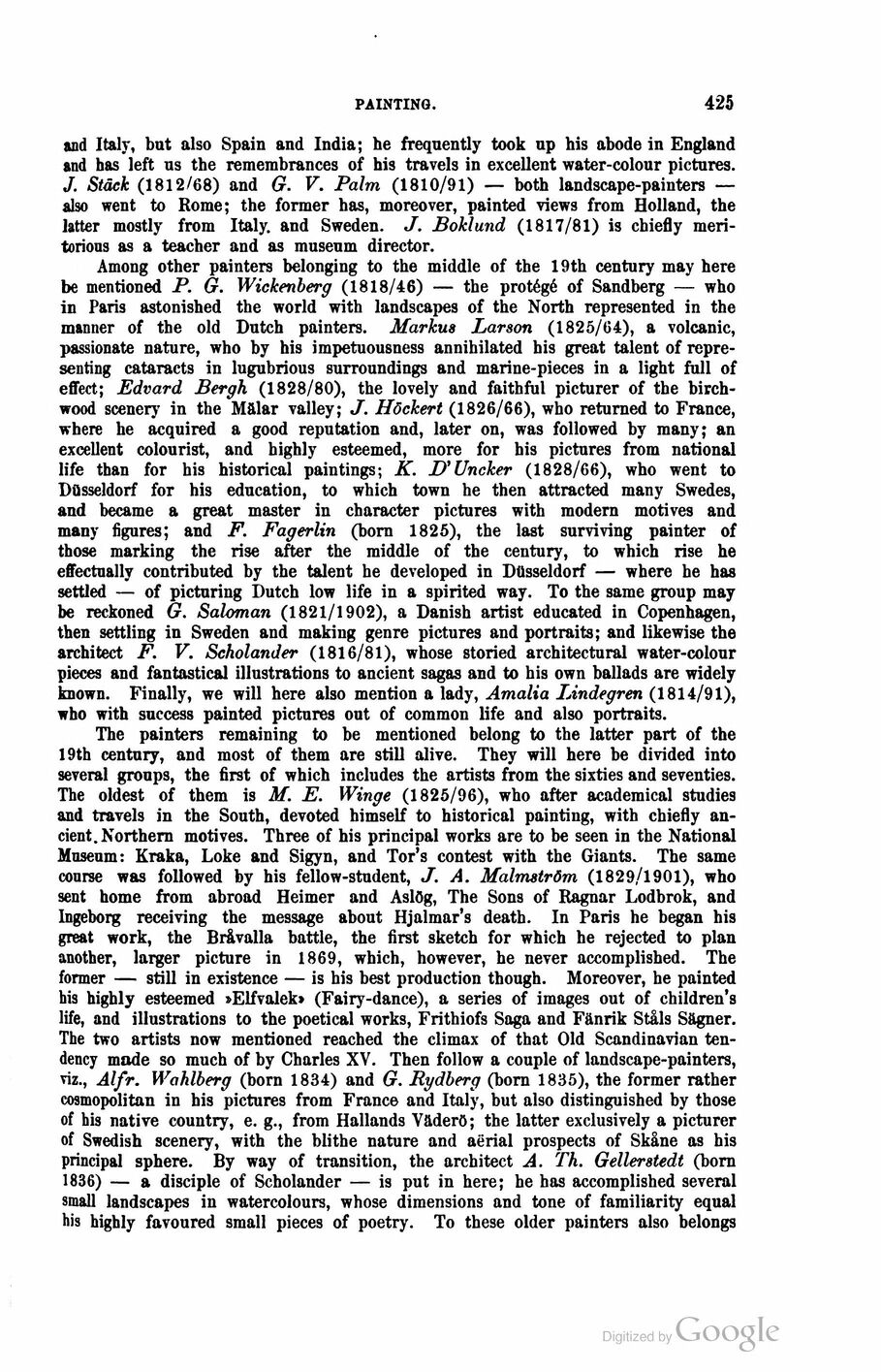
Full resolution (JPEG) - On this page / på denna sida - First part - IV. Education and Mental Culture - 9. The Fine Arts - Painting, by Prof. C. R. Nyblom, Ph. D., Stockholm

<< prev. page << föreg. sida << >> nästa sida >> next page >>
Below is the raw OCR text
from the above scanned image.
Do you see an error? Proofread the page now!
Här nedan syns maskintolkade texten från faksimilbilden ovan.
Ser du något fel? Korrekturläs sidan nu!
This page has never been proofread. / Denna sida har aldrig korrekturlästs.
PAINTING.
425
and Italy, but also Spain and India; be frequently took np his abode in England
and has left us the remembrances of his travels in excellent water-colour pictures.
J. Stack (1812/68) and G. V. Palm (1810/91) — both landscape-painters —
also went to Rome; the former has, moreover, painted views from Holland, the
latter mostly from Italy, and Sweden. J. Boklund (1817/81) is chiefly
meritorious as a teacher and as museum director.
Among other painters belonging to the middle of the 19th century may here
be mentioned P. G. Wickenberg (1818/46) — the protégé of Sandberg — who
in Paris astonished the world with landscapes of the North represented in the
manner of the old Dutch painters. Markus Larson (1825/64), a volcanic,
passionate nature, who by his impetuousness annihilated his great talent of
representing cataracts in lugubrious surroundings and marine-pieces in a light full of
effect; Edvard Bergh (1828/80), the lovely and faithful picturer of the
birch-wood scenery in the Mälar valley; J. Höckert (1826/66), who returned to France,
where he acquired a good reputation and, later on, was followed by many; an
excellent colourist, and highly esteemed, more for his pictures from national
life than for his historical paintings; K. D’Uncker (1828/66), who went to
Düsseldorf for his education, to which town he then attracted many Swedes,
and became a great master in character pictures with modern motives and
many figures; and F. Fagerlin (born 1825), the last surviving painter of
those marking the rise after the middle of the century, to which rise he
effectually contributed by the talent he developed in Düsseldorf — where he has
settled — of picturing Dutch low life in a spirited way. To the same group may
be reckoned G. Saloman (1821/1902), a Danish artist educated in Copenhagen,
then settling in Sweden and making genre pictures and portraits; and likewise the
architect F. V. Scholander (1816/81), whose storied architectural water-colour
pieces and fantastical illustrations to ancient sagas and to his own ballads are widely
known. Finally, we will here also mention a lady, Amalia Lindegren (1814/91),
who with success painted pictures out of common life and also portraits.
The painters remaining to be mentioned belong to the latter part of the
19th century, and most of them are still alive. They will here be divided into
several groups, the first of which includes the artists from the sixties and seventies.
The oldest of them is M. E. Winge (1825/96), who after academical studies
and travels in the South, devoted himself to historical painting, with chiefly
ancient. Northern motives. Three of his principal works are to be seen in the National
Museum: Kraka, Loke and Sigyn, and Tor’s contest with the Giants. The same
course was followed by his fellow-student, J. A. Malmström (1829/1901), who
sent home from abroad Heimer and Aslög, The Sons of Ragnar Lodbrok, and
Ingeborg receiving the message about Hjalmar’s death. In Paris he began his
great work, the Bråvalla battle, the first sketch for which he rejected to plan
another, larger picture in 1869, which, however, he never accomplished. The
former — still in existence — is his best production though. Moreover, he painted
his highly esteemed »Elfvalek» (Fairy-dance), a series of images out of children’s
life, and illustrations to the poetical works, Frithiofs Saga and Fänrik Ståls Sägner.
The two artists now mentioned reached the climax of that Old Scandinavian
tendency made so much of by Charles XV, Then follow a couple of landscape-painters,
viz., Alfr. Wahlberg (born 1834) and G. Rydberg (born 1835), the former rather
cosmopolitan in his pictures from France and Italy, but also distinguished by those
of his native country, e. g., from Hallands Väderö; the latter exclusively a picturer
of Swedish scenery, with the blithe nature and aerial prospects of Skåne as his
principal sphere. By way of transition, the architect A. Th. Gellerstedt (born
1836) — a disciple of Scholander — is put in here; he has accomplished several
small landscapes in watercolours, whose dimensions and tone of familiarity equal
his highly favoured small pieces of poetry. To these older painters also belongs
<< prev. page << föreg. sida << >> nästa sida >> next page >>